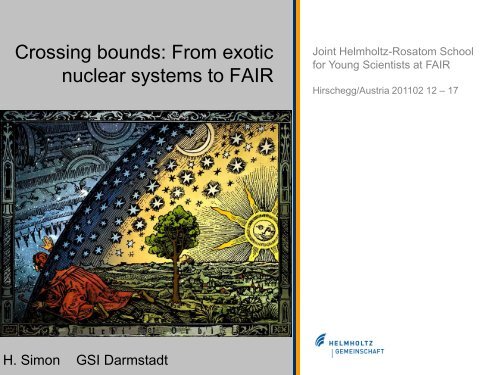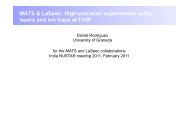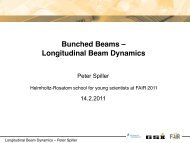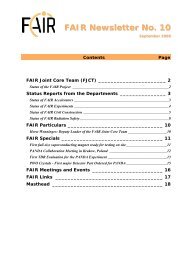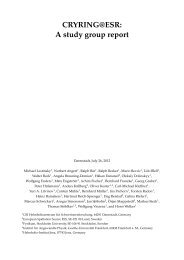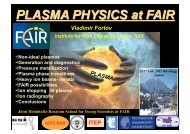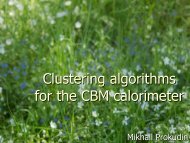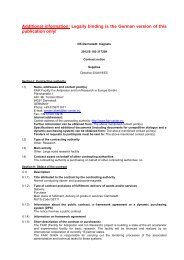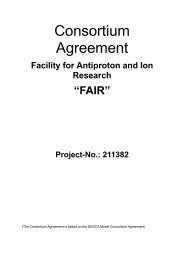NUSTAR, Super-FRS, Fixed Target Physics and In-ring Experiments
NUSTAR, Super-FRS, Fixed Target Physics and In-ring Experiments
NUSTAR, Super-FRS, Fixed Target Physics and In-ring Experiments
- No tags were found...
You also want an ePaper? Increase the reach of your titles
YUMPU automatically turns print PDFs into web optimized ePapers that Google loves.
Crossing bounds: From exoticnuclear systems to FAIRJoint Helmholtz-Rosatom Schoolfor Young Scientists at FAIRHirschegg/Austria 201102 12 – 17H. Simon GSI Darmstadt
My main projectsELISe e - scatte<strong>ring</strong>with radioactive beamsElectronics for<strong>NUSTAR</strong>/FAIRTacquilast 10ps electronic50 kHz events/sunstablenuclear systemsOnline PSA @ 100MHzst < 100ps/kmBuTiS campus clockH. Simon ● Crossing bounds: From exotic nucl. sys. to FAIR 2/90
Menu1. <strong>NUSTAR</strong>: Nuclear Structure Astrophysics & Reactions2. Halo Nuclei: Low density nuclear matter3. Extremely neutron rich systems4. EOS studies via nuclear excitations5. The future is FAIR6. SummaryH. Simon ● Crossing bounds: From exotic nucl. sys. to FAIR3/90
Stellar environmentsWhat do we know ? And how ….• Primary input to Astrophysics is theobservations of (very) distant objectsthrough astronomers indirect measurements• At the first glance for we just lookat rather hot surfaces of stars …SunH. Simon ● Crossing bounds: From exotic nucl. sys. to FAIR 4/90
Magnitude/Distance analysis (<strong>In</strong>verse Square Law)Apparent magnitude <strong>and</strong>absolute magnitude(or luminosity) can only berelated if distance is known !F = L / ( 4 p r 2 )Example: solar luminosityL sol = 3.846×10 26 W@ 1AU flux is F = 1365 W m -2@ 10pc it is F = 3.208 ×10 -10 W m -2 comparison is done at 10pc(absolute magnitude)H. Simon ● Crossing bounds: From exotic nucl. sys. to FAIR 6/90
Spectral analysis (blackbody radiation)Wiens law max T = 0.0029 m K3000 K – 970 nm (IR)10000K – 290 nm (UV)Betelgeuse (~ 3000 K)Orion<strong>and</strong> (wave length dependend)classification (+ absorption lines)Riegel (~ 10000 K)H. Simon ● Crossing bounds: From exotic nucl. sys. to FAIR 8/90
Spectral analysis (blackbody radiation)<strong>and</strong> conditions how the light wasemitted …Stefan-Boltzmann eq.(s = 5.67… 10 -8 W m -2 K -4 )L = 4p R 2 s T 4e.g. Sun T: 5777KR: 0.6955 Mio km L: 3.839 ×10 26 W Model inputT, L, R from M, m, r & absorptionH. Simon ● Crossing bounds: From exotic nucl. sys. to FAIR 9/90
Lifetime measurements with radioisotopesa147Sm 143 Nd, T 1/2 :1.06 x 10 11 y144Nd a decay, T 1/2 :2.29 x 10 15 y Moon surface is ~ 5 x 10 9 y oldAppollo 15: “genesis rock”… so the sun should beas old (at least) !H. Simon ● Crossing bounds: From exotic nucl. sys. toFAIRH. Simon ● Crossing bounds: From exotic nucl. sys. to 10/90
abundanceConsequences:Stars use nuclear energy (fusion) seed production up ~ A=56 „slow‟ processsolar abundancesAnd how are heavierelements (A ≥ 56 )produced ?H,He96-99%iron peakstructuresbroad & narrowLi,Be,Bsuppressed2.24g Aumass number AH. Simon ● Crossing bounds: From exotic nucl. sys. to FAIR 11/90
… predominantly via slow <strong>and</strong> rapid neutron capture1. 2.Summary of thedominant processesWhy (<strong>and</strong> where) are radioactivebeams involved ?Examples:1. pp (III) in the sun2. r-process3. n-star EOSH. Simon ● Crossing bounds: From exotic nucl. sys. to FAIR 12/90
Tomography of the sun via neutrinos !… <strong>and</strong> radioactive isotopes in the sunsimple idea 4p 4 He + 2e + + 2Dmc 2 = 26.73 MeVQ eff = Dmc 2 – E however:H. Simon ● Crossing bounds: From exotic nucl. sys. to FAIR 13/90
7Be + p 8 B + g in the laboratory (direct measurement)7Be is unstable (T 1/2 = 53d)Temperature in the sun: ~ 15 Mio Kav. kin. energy 3 / 2 kT = 8,6 · 10 −5 eV/K * 1.5 · 10 7 K = 1290 eV high energy tail of Boltzmann distribution e -E/kTMax.: (bkT/2) 2/3 =1.22 (Z 12 Z 22 µT 62 ) 1/3 keVCoulomb repulsion tunneling through barrier e -b/√Ep-p low energy x-sec(de Broglie wave length) p (h/p)² i.e. 1/E Maximum 7 Be(p ,g) @ 18keV,very low energy on MeV scale !LUNA (2009): 3He(α, γ) 7 Be0.02 pb ( 2 events/m ) @ 16keVsearching for a resonancearound 22keV (Gamov peak).H. Simon ● Crossing bounds: From exotic nucl. sys. to FAIR 14/90
Possible way out …Coulomb dissociation (CD)Study inverse process (detailed balance)8B is unstable (T 1/2 = 0.77s) 8 B(g,p) measure cross section s CD <strong>and</strong>relative energy 7 Be <strong>and</strong> p (starts at 0 threshold)dσdECDγ1Eγvirtual photon theorydnσ(g , p)dEgσdetailed balance2 2J7Be1) 2Jp1)kcm2 ( p,g )2 2J 1) k( g , p)σ8Bgk γ = (E rel +Q)/ћc k cm2 = 2μE rel /ћ 2 Q=138 keVH. Simon ● Crossing bounds: From exotic nucl. sys. to FAIR 15/90
Both methods work … <strong>and</strong> deliver comparable results !s(E) = S(E) / E e -b/√E S(E) describes nuclear structureCDfit(p,g)Extrapolationfrom 100keVto relevantlow energystill necessary !resolution (CD)vs.rate (direct)H. Simon ● Crossing bounds: From exotic nucl. sys. to FAIR 16/90
To be explained …Radioactive Beam Studies:Specific (x, g) reactions4He(2n,g) 6 He, 7 Be(p,g) 8 B, 14 C(n,g) 15 C, 26 S(p,g) 27 P, 15 O(2p,g) 17 Ne,31,32Cl(p,g) 32,33 Ar, …Structure input forextrapolationof nuclear dataNeutron mattervery exotic systems,xn, 5,7 H, 9,10 He, 12,13 Li, …precise study asymmetryEOS via excitationsH. Simon ● Crossing bounds: From exotic nucl. sys. to FAIR 17/90
At the Outskirts: Three bodies find togetherT. Baumann et al., Nature 449 (2007) 1022H. Simon ● Crossing bounds: From exotic nucl. sys. to FAIR18/90
<strong>Physics</strong> with radioactive beamsNuclear Structureof exotic nucleiNeutron-Protonasymmetric matterNuclear AstrophysicsH. Simon ● Crossing bounds: From exotic nucl. sys. to FAIR 19/90
What„s exotic in Exotic Nucleibubbledecrease of central densitybinding energies (B) of valence nucleons smallproton <strong>and</strong> neutron density distributions differH. Simon ● Crossing bounds: From exotic nucl. sys. to FAIR 20/90
Exotica: HaloesH. Simon ● Crossing bounds: From exotic nucl. sys. to FAIR21/90
The nuclear HaloThreshold phenomenon resulting from a bound stateclose to the continuumLow separation energy + short range of nuclear forceallow tunnelling into the space surrounding the coree.g. 11 BeSpatially separatedclusters ( r) rer2mSnH. Simon ● Crossing bounds: From exotic nucl. sys. to FAIR22/90
Cross section reflects size (Tanihata 1985)s ( p,t) p[R ( p) R ( t)]III2Be, C <strong>and</strong> Al11Li 21/2σI r matterR( 11 Li) = 3.10(14) fmI. Tanihata et al., PRL 55 (1985) 2676H. Simon ● Crossing bounds: From exotic nucl. sys. to FAIR 23/90
Transmission ExperimentR. Kanungo et al.,PRL 102(2009)152501H. Simon ● Crossing bounds: From exotic nucl. sys. to FAIR 24/90
PRL 104 (2010) 06270119,20,22C @ 40 MeV/u10 counts/h rms matterradius: 5.4 0.9 fmS 2n :10 keV420 keVH. Simon ● Limits Crossing of existence bounds: From of Light exotic Nucleinucl. sys. to FAIR25/90
Shell reorde<strong>ring</strong>: Halo formationMean-field modificationssurface composed of diffuseneutron matterderivative of mean field potential weaker<strong>and</strong> spin-orbit interaction reducedJ. Dobaczewski, et al.Phys.Rev. C53 (1996) 2809Nucleon-nucleon interactionsstt interaction :coupling of p-n spin-orbit partnersin partly occupied orbitsO: missing pd 5/2 do not bind d 3/2 N=16T.Otsuka et al.,PRL87 (2001) 082502(tensor) PRL95 (2005) 232502Repulsive 3N forceT.Otsuka et al., PRL105 (2010) 03250124O28OH. Simon ● Crossing bounds: From exotic nucl. sys. to FAIR26/90
Bridging the A=5,8 gaps for heavy element creationM. Terasawa et al., APJ562(2001)470A. Bartlett et al., PRC74(2006) 015802• Bypass reactions to triple-α process stellar burning• 8Be(n,γ ) 9 Be(α,n) 12 C e.g. core collapse supernovae• 4He(2n,γ) 6 He(α,n) 9 Be possibly n-star mergersH. Simon ● Crossing bounds: From exotic nucl. sys. to FAIR27/90
Continuum spectroscopyCoulomb dissociation:E x 10 MeV 100% cluster sumrule B(E1) = 1.2(0.2) e²fm²( 4 He(2n,γ) 6 He backwards)T. Aumann et al., PRC59(1999)1252 1/2 = 3.4(4) fm 1/2 exp. = 2.016(72) fm 1/2 exp. = 2.068(11) fm (laser spectroscopy)P. Mueller et al. PRL99 (2007) 252501 1/2 theo. = 2.059 fmB.V. Danilin et al., NPA632 (1998) 383H. Simon ● Crossing bounds: From exotic nucl. sys. to FAIR28/90
Elastic proton scatte<strong>ring</strong>- inverse kinematicsP. Egelhof et al.,EPJA15(2002)27d nn = 4.0(4) fm 1/2 = 3.4(4) fm6He,SOG6 1/2 = 3.0(3) fmH. Simon ● Crossing bounds: From exotic nucl. sys. to FAIR29/90
ALADIN-LAND Setup (kinematically complete)<strong>Target</strong>H. Simon ● Crossing bounds: From exotic nucl. sys. to FAIR30/90
Experimental Setup (less schematic)H. Simon ● Crossing bounds: From exotic nucl. sys. to FAIR 31/90
Exotic structure across the dripline:P.G. Hansen, Nature 328 (1987) 476p knockout most exotic systems nearly unbiased & clean production !H. H. Simon ● Crossing bounds: From exotic nucl. sys. to to FAIR32/90
Explo<strong>ring</strong> Unbound Lithium isotopes14B14Be12Li12Li12Lia s (fm)S n (MeV)-13.7(1.6) 1.47(0.19)Close toS 2n14Be„consistent‟Y. Aksyutina et al., PLB666 (2008) 430C. Hall et al., PRC81 (2010) 021302H. Simon ● Crossing bounds: From exotic nucl. sys. to FAIR33/90
Explo<strong>ring</strong> Unbound Lithium isotopes13Li: 14 Be + p 11 Li + n + n14Be13Lids/dE noFSI E 2 /(2.21 S 2n + E) 7/2 K 0 =0C. Forssén, B. Jonson, M.V. ZhukovNPA673 (2008) 143Momentum transfer small,11Li core survives collision ! 11 Li + 2n resonance pictureEvidence for existenceat 1.47(31) MeV. Angular correlations …Y. Aksyutina, H. Johansson et al., PLB666 (2008) 430H.T. Johansson, Y. Aksyutina, Nucl. Phys. A847 (2010) 66H. Simon ● Crossing bounds: From exotic nucl. sys. to FAIR34/90
<strong>In</strong>tensities for detailed studiesprimary beam~ 0.5 GeV/u~ 10 10 /sproductiontargetsecondary beam~ 10 – 1000 /sreaction target~ 1%,~ 1g/cm² C“ternary beam”~ 0.1 – 10 /s50mH. Simon ● Crossing bounds: From exotic nucl. sys. to FAIR35/90
Results <strong>and</strong> current limits …14Be• Comprehensive studyof exotic unbound systemswith extreme A/Z• Structure informationunveiled10Li 11Li12Li6He 7 He 8 He 9 He 10 He5Hnew data13Lifirst time !25F 26 F 27 F24O 25 O 26 O• e.g.Unbound oxygen isotopesH. Simon ● Crossing bounds: From exotic nucl. sys. to FAIR36/90
Results <strong>and</strong> current limits …14Be• Comprehensive studyof exotic unbound systemswith extreme A/Z• Structure informationunveiled10Li 11Li12Li6He 7 He 8 He 9 He 10 He5H13Lifirst time !25F 26 F 27 F24O 25 O 26 O• e.g.Unbound oxygen isotopesH. Simon ● Crossing bounds: From exotic nucl. sys. to FAIR 37/90
What next ? <strong>Target</strong> recoil detection !L.V. Chulkov et al., Nucl. Phys. A759(2005)43T. Neff et al., Nucl. Phys. A752(2005)321cDirect observation ofkinematical correlations liquid hydrogen or CH 2 target& recoil proton detection(i) (Cluster) spectroscopic factors(p,2p),(p,pn),(p,px) inv. kinematics(ii) clean production of 4 H, 7 H,…via α knockout !H. Simon ● Crossing bounds: From exotic nucl. sys. to FAIR38/90
Quasi-free scatte<strong>ring</strong> in inverse kinematicsn,p, ...projectile Z,ACH2targetprotonSi, stripx, DEBCsI, NaIredundant experimental information:kinematical reconstruction from proton momentaplus gamma rays, recoil momentum, invariant masssensitivity not limited to surface→ spectral functions→ knockout from deeply bound statescluster knockout reactionsH. Simon ● Crossing bounds: From exotic nucl. sys. to FAIR 39/90
New <strong>Experiments</strong> (Aug/Sep 2010)R³B/FAIR precursor: Setup at Cave Cp 16mm(p,2p) CH 2 targetCoulomb Diss. Pbproton <strong>and</strong> gammadetectionproton tracking behind magnetwith drift chambers (100 80 cm 2 )resolution ~200 mH. Simon ● Crossing bounds: From exotic nucl. sys. to FAIR40/90
Experimental Setup (less schematic)H. Simon ● Crossing bounds: From exotic nucl. sys. to FAIR 41/90
QFS with Exotic Nuclei: 17 Ne(p,2p) 15 O+pThe two-proton Halo (?) nucleus 17 NeNucleus of interestqAExcited FragmentA-1Evaporationp,n,d,t,...Bound Proton2Recoil qPhoton(s)Scattered Protons:0Free <strong>Target</strong> Proton1• opposite angles• opening angle 90°<strong>In</strong>ternal MomentumSeparation Energyq pA 1 p1 p2p0ES T1T2TA1T0Pilot experiments with 12 C, 17 Ne <strong>and</strong> Ni isotopesalready performed at the LAND-R3B setup areunder analysis …Angular Correlations measured with Si-stripdetectors for17Ne(p,2p) 15 O+pD~180°, D~83° (sim. as for free pp scatte<strong>ring</strong>)H. Simon ● Crossing bounds: From exotic nucl. sys. to FAIR 42/90
The origin of elementsDsRgSunBig bang nucleosythesisHydrogen Burning CNOHelium BurningCarbon burningNeon burningOxygen burningSilicon burningEquilibrium reactions/PhotodesintegrationSpallation in the ISMs-process/p-process in AGB starsr-process in <strong>Super</strong>novaeEta CarinaeH. Simon ● Crossing bounds: From exotic nucl. sys. to FAIR 43/90
10 1Nucleosynthesis ( A ≥ 56 )e.g. r-process (~5x10 9 K)(n,g) ↔ (g,n)n ≥ 10 20 cm -310 0323028343610 -13810 -2404210 -34644482628 6030 32 34 36 38 40 42 44 46 48 50 52 54 56 5850525456586062646668100 150 200 25062 64 66 68 70 72707274 7674767880828478 80 82 84 86 88 90 92 94 96 98 100 102 104 106 108 110 112 11486116 118120 122 124 126 128 130 132 134 136 138K.L. Kratz, H. Schatz, B. Pfeiffer889092949698140 142 144 146 148 150 152 154 156 158r-bumps explained, dependstrongly on nuclear structureextrapolation !ETFSI-QH. Simon ● Crossing bounds: From exotic nucl. sys. to FAIR 44/90100SN II, core collapse160162164 166 168 170 172 174176 178 180 182 184186188 190
Nucleosynthesis in the r-process (rapid neutron capture)H. Simon ● Crossing bounds: From exotic nucl. sys. to FAIR 45/90
The dipole response of n-rich nuclei <strong>and</strong> the r-processr-process abundanceS. Goriely <strong>and</strong> E. Khan,Nucl.Phys.A706 (2002) 217E. Litvinova et al.,Nucl. Phys. A 823 (2009) 26(rapid neutron capture)H. Simon ● Crossing bounds: From exotic nucl. sys. to FAIR 46/90
Studies of neutron-rich nuclei in the laboratory (survey)Pygmy Resonances enhance (g,n) via direct capture ?!chargedfragmentsPb targetneutronsE* from relative& gamma energiesgamma radiationconversionto photoabsorptionResult: There is low lying strength !H. Simon ● Crossing bounds: From exotic nucl. sys. to FAIR 47/90
Can we learn something on neutron matter?Neutron StarThe nuclear equation of state:dependence on n-p asymmetry <strong>and</strong> density- symmetry energy <strong>and</strong> its density dependence close to saturation density→ properties of n-rich nuclei ?Dipole vibrations, neutron-skin thickness- symmetry energy at higher densities → reactions with n-rich nuclei (n-p flow)H. Simon ● Crossing bounds: From exotic nucl. sys. to FAIR 48/90
Dipole-strength distributions in neutron-rich Sn isotopesP. Ring et al.Electromagnetic-excitationcross sectionPhoto-neutron cross sectionstableradioactiveP. Adrich et al., PRL 95 (2005) 132501PDR• located at 10 MeV• exhausts a few % TRK sum rule• in agreement with theoryGDR• no deviation from systematicsH. Simon ● Crossing bounds: From exotic nucl. sys. to FAIR 49/90
ΣB PDR (E1)/ΣB GDR (E1) [%]Pygmy dipole strength, Neutron Skin,<strong>and</strong> the Equation of State of neutron-rich MatterRelation between dipole strength <strong>and</strong> n-skin thicknessn-skin thickness derived from dipole strengthRRPA (DD-ME2,a 4 =30-38 MeV)132Sniv GDRPygmyneutron skin thickness [fm]"...,the pygmy dipole resonance may place importantconstraints on the neutron skin of heavy nuclei <strong>and</strong>, as aresult, on the equation of state of neutron-rich matter."J. Piekarewicz, PRC 73 (2006) 044325Constraints on EoS of neutron-rich matterderived from dipole strength of n-rich Snisotopessymmetry energy a 4 = 32.0 ± 1.8 MeVpressure p o = 2.3 ± 0.8 MeV/fm 3H. Simon ● Crossing bounds: From exotic nucl. sys. to FAIR 50/90
Additional <strong>In</strong>formation from g spectroscopyS nA. Klimkiewicz et al.,Phys. Rev. C 76 (2007) 051603(R)H. Simon ● Crossing bounds: From exotic nucl. sys. to FAIR 51/90
<strong>In</strong>termittend Summary: Why do we study nuclear physics …- Towards a Consistent Underst<strong>and</strong>ing of the Atomic Nucleus•What are the limits for existence of nuclei?–Where are the proton <strong>and</strong> neutron drip lines situated?–Where does the nuclear chart end?•How does the nuclear force depend on varying proton-toneutronratios?–What is the isospin dependence of the spin-orbit force?–How does shell structure change far away from stability?•How to explain collective phenomena from individual motion?–What are the phases, relevant degrees of freedom, <strong>and</strong> symmetries ofthe nuclear many-body system?•How are complex nuclei built from their basicconstituents?–What is the effective nucleon-nucleon interaction?–How does QCD constrain its parameters?•Which are the nuclei relevant for astrophysical processes<strong>and</strong> what are their properties?–What is the origin of the heavy elements?52H. Simon ● Crossing bounds: From exotic nucl. sys. to FAIR 52/90
Prepa<strong>ring</strong> for FAIR ~2017/18<strong>In</strong>tensity increase 3-4 orders of magnitude !H. Simon ● Crossing bounds: From exotic nucl. sys. to FAIR53/90
Production of radioactive beams: MethodsH. Geissel, G. Münzenberg, K. Riisager, Annu. Rev. Nucl. Part. Sci. 45 (1995) 163ISOL:- spallation (~1 GeV protons)- fission: p-induced, fast neutrons(d beam), slow neutrons (reactor),photons (e - beam)- fusion/evaporation, multi-nucleontransferIN-FLIGHT:relativistic heavy ions(50 MeV/u – 1 GeV/u)- fragmentation- fission (elm. or nuclear induced)H. Simon ● Crossing bounds: From exotic nucl. sys. to FAIR 54/90
RIBs produced by fragmentation or fissionSn isotopes<strong>In</strong>teraction zoneCoulomb field(time of flight through <strong>FRS</strong> ~300ns)H. Simon ● Crossing bounds: From exotic nucl. sys. to FAIR 55/90
Layout <strong>and</strong> Design parametersfor the <strong>Super</strong>-<strong>FRS</strong>Goal: Larger AcceptanceH. Simon ● Crossing bounds: From exotic nucl. sys. to FAIR 56/90
Comparison of <strong>FRS</strong> with <strong>Super</strong>-<strong>FRS</strong>, intensity gain<strong>FRS</strong><strong>Super</strong>-<strong>FRS</strong><strong>Super</strong>-<strong>FRS</strong>X 10X 30<strong>FRS</strong>ZH. Simon ● Crossing bounds: From exotic nucl. sys. to FAIR 57/90
Separation Performance of the <strong>Super</strong>-<strong>FRS</strong>238 21.1 A GeV U on 4 g/cm C target, two Al degraders d/R=0.3, d/R=0.7Pre-SeparatorPre-SeparatorFeatures of two degrader stages• <strong>In</strong>troduction of another separation Main-Separator cut the A-Z plane• Reduction of contaminants Main-Separator from fragments produced in the degrader• Optimization of the fragment rate on detectors in the Main-Separator• Possible usage of Pre- <strong>and</strong> Main-Separator for secondary reaction studiesZ238UZZZNH. Simon ● Crossing bounds: From exotic nucl. sys. to FAIR 58/90NNN
Production of radioactive beamsby fragmentation <strong>and</strong> fissionH. Geissel et al., NIMB204 (2003) 71H. Simon ● Crossing bounds: From exotic nucl. sys. to FAIR 59/90
Detector <strong>In</strong>strumentation of the <strong>Super</strong><strong>FRS</strong>Requirement:Slow <strong>and</strong>fast extraction !TOFTOF, dETOF, dETOF, dETOF, dE10 12 /s
Br-DE-TOF method: RequirementsNO CHARGE STATES !Br=A/Z・b・gTOF=L/βΔE~Z 2 /β 2A/Z, PZPos res. σ 1 mmTiming res. σ: 50 psΔE resolution σ: 1-2 %• Position:• ΔE:• TOF:Wirechambers (single event readout)/DiamondMUSIC/TEGICPlastic/DiamondH. Simon ● Crossing bounds: From exotic nucl. sys. to FAIR 61/90
Fast sampling & timing techniques‣ Challenge:‣ Beam identification at rates up to 1MHz.‣ ToF over km distance with sub-ns resolution.‣ DE resolution 2-3%Tacquilast 10ps electronic‣ Solution:‣ Fast sampling <strong>and</strong> FPGA based digital signalprocessing & pulse shape analysis.‣ Campus wide Time Distribution System basedon FAIR BuTiS timing system.‣ TAC or DLL based Frontends.50 kHz events/sOnline PSA @ 100MHz‣ First studies using Tacquila@R³B/Cave-C.‣ Digital Signal Processing (for PSP, MUSIC) incollaboration with KVI Groningen/JSI Lubljanast < 100ps/kmBuTiS campus clockH. Simon ● Crossing bounds: From exotic nucl. sys. to FAIR 62/90
<strong>FRS</strong> & RISING <strong>Super</strong>-<strong>FRS</strong> HISPEC/DESPECproductionselectionidentificationspectroscopy~300MeV/uH. Simon ● Crossing bounds: From exotic nucl. sys. to FAIR 63/90
CountsCounts882Coulomb excitationof a primary beam – 84 KrM. Gorska84Kr (113 AMeV) + Au (0.4 g/cm 2)MW MW<strong>Target</strong>gQ gQ pCATESi CsIwithout Doppler correctionEg [keV]Particle identification before<strong>and</strong> after the targetForward scatte<strong>ring</strong> angleselection<strong>Fixed</strong> b= 0.4 valueEvent by event Dopplercorrection84Kr 2 + 0 + FWHM ~ 1.5 %Eg [keV]H. Simon ● Crossing bounds: From exotic nucl. sys. to FAIR 64/90
New Shell Structure: Cr isotopes• B(E2) values for 56,58 Cr(lifetime/x-sec/energy)E g[keV]N ionsI geff.cor. .B(E2)[Wu]B(E2) [Wu]54Cr 835 3.0·10 7 21300 Normalisation14.6(6)56Cr 1006 1.5·10 7 6500 8.7 (3.0) ---58Cr 880 1.0·10 7 7800 14.8 (4.2) ---<strong>In</strong>dication for N=32 sub-shell closureA. Bürger et al., Phys. Lett B622, 29 (2005)H. Simon ● Crossing bounds: From exotic nucl. sys. to FAIR 65/90
RISING PRESPEC HISPEC/DESPEC<strong>Target</strong>H. Simon ● Crossing bounds: From exotic nucl. sys. to FAIR 66/90
<strong>NUSTAR</strong> <strong>Experiments</strong>(NUclear STructure Astrophysics <strong>and</strong> Reactions)Exotic Nuclei• Spectroscopy• Reactions• Mass/gs. prop.HI/DESPECLASPEC,MATSR 3 BILIMAschematicEXL : hadron scatte<strong>ring</strong>ELISe : electron scatte<strong>ring</strong>AIC : antiproton scatte<strong>ring</strong>H. Simon ● Crossing bounds: From exotic nucl. sys. to FAIR67/90
<strong>NUSTAR</strong> <strong>Experiments</strong> (Start version)(NUclear STructure Astrophysics <strong>and</strong> Reactions)Exotic Nuclei• Spectroscopy• Reactions• Mass/gs. prop.HI/DESPECLASPEC,MATSR 3 BILIMAschematicEXL : hadron scatte<strong>ring</strong>ELISe : electron scatte<strong>ring</strong>AIC : antiproton scatte<strong>ring</strong>H. Simon ● Crossing bounds: From exotic nucl. sys. to FAIR68/90
Mass: Fundamental Property of Nuclei‣ Binding energies• Mass models• Shell structureMass matters !‣ Correlations• pai<strong>ring</strong>‣ Reaction phase space• Q-values• Reaction probabilities‣ The reach of nuclei• Drip lines‣ Nuclear astrophysics• Paths of nucleosynthesis‣ Fundamental symmetries‣ Metrology‣ …..Y. LitvinovH. Simon ● Crossing bounds: From exotic nucl. sys. to FAIR 69/90
Importance of Atomic Masses<strong>Physics</strong> &Chemistrybasic informationrequireddm/m 1·10 -5Nuclear<strong>Physics</strong>nuclear binding energies,Q-valuesdm/m 1·10 -7NuclearStructureshell closure, pai<strong>ring</strong>,deformation, halosdm/m 1·10 -7Weak<strong>In</strong>teractionsymmetry tests,CVC hypothsisdm/m < 3·10 -8Astrophysicsnuclear synthesis,r- <strong>and</strong> rp-processdm/m < 1·10 -6dm/m 1·10 -5NuclearModelstests of nuclear models<strong>and</strong> formulaeH. Simon ● Crossing bounds: From exotic nucl. sys. to FAIR 70/90
ILIMA: Set-UpIsochronous Mass Spectrometryin the CRSchottky Mass Spectrometryin the CR & NESRH. Simon ● Crossing bounds: From exotic nucl. sys. to FAIR 71/90
SMS <strong>and</strong> IMSSCHOTTKY MASS SPECTROMETRYISOCHRONOUS MASS SPECTROMETRY<strong>In</strong>jectionv(m/q) 01v 1<strong>In</strong>jectionSchottkyNoise-Pickups(m/q)>(m/q)>(m/q)>(m/q)SeptumElectronCoolerTOF-Detectorv 1v 0(m/q) 0(m/q) 0(m/q) 1SeptumCooled FragmentsDffDvv0 g t= 1 D(m/q)m/q+g 2tH. Simon ● Crossing bounds: From exotic nucl. sys. to FAIR 72/90Dvvgg 2g 2t(1 )Hot Fragments
Schottky Pick-Up in the ESRH. Simon ● Crossing bounds: From exotic nucl. sys. to FAIR 73/90
SMS: Broad B<strong>and</strong> Frequency SpectraH. Simon ● Crossing bounds: From exotic nucl. sys. to FAIR 74/90
Time-of-Flight detector for the IMSMCPsAnodeESecondaryelectronsBIonFoilPotentialPlatesH. Simon ● Crossing bounds: From exotic nucl. sys. to FAIR 75/90
ILIMA: Masses <strong>and</strong> Halflivesstable nucleinuclides with known massesG.Audi et al., Nucl. Phys. A729 (2003) 3to measured be measured at <strong>FRS</strong>-ESR with SUPER-<strong>FRS</strong>-CR-RESR-NESRexisting (published) <strong>FRS</strong>-ESRConceptual GSI report C. Design Scheidenberger Report, GSI et 2001 al., 2002measured at <strong>FRS</strong>-ESR (in analysis)observed nuclei82observed nuclei126r-processpath5082282050882028H. Simon ● Crossing bounds: From exotic nucl. sys. to FAIR 76/90
<strong>NUSTAR</strong> <strong>Experiments</strong>(NUclear STructure Astrophysics <strong>and</strong> Reactions)Exotic Nuclei• Spectroscopy• Reactions• Mass/gs. prop.HI/DESPECLASPEC,MATSR 3 BILIMAschematicEXL : hadron scatte<strong>ring</strong>ELISe : electron scatte<strong>ring</strong>AIC : antiproton scatte<strong>ring</strong>H. Simon ● Crossing bounds: From exotic nucl. sys. to FAIR77/90
Reactions with Relativistic Radioactive Beams(2017/18)RIB from<strong>Super</strong>-<strong>FRS</strong>Largeacceptancedipole magnet• <strong>Target</strong>• Tracker• CalorimeterNeutronsProtonsHeavyfragmentsSpokesperson: T. Aumannhttp://www.gsi.de/fair/experiments/<strong>NUSTAR</strong>/R3b.htmlH. Simon ● Crossing bounds: From exotic nucl. sys. to FAIR78/90
Reactions with Relativistic Radioactive Beams (full)Calorimeter<strong>Target</strong>-recoildetectorNeuLANDHigh-resolution modeLargeacceptancemodeNeuLANDDiamond- <strong>and</strong> Si-Strip detectorsalternative: active targetalternative: multi-track detectorKinematically complete measurement of reactions with high-energy secondary beamsNuclear AstrophysicsStructure of exotic nucleiNeutron-rich matterH. Simon ● Crossing bounds: From exotic nucl. sys. to FAIR 79/90
R3B Si Recoil Trackerproject started 1 April 2009• <strong>In</strong>stallation at R3B in 2013Tasks:• Simulations of target-recoil detector• elastic, inelastic, quasifree …• Si-microstrip prototype testing• micro-strip, MAPS …• Si tracker mechanical design• Mechanical integration of target-recoil detector sub-systems• with LH2 target <strong>and</strong> calorimeter• FEE <strong>and</strong> DAQR3B conceptual designfor Si tracker FEE <strong>and</strong> DAQ<strong>NUSTAR</strong>DABCDAQBUTIS• 100k channels, new ASIC design (low thresholds, self-trigge<strong>ring</strong>)• Si-tracker construction, assembly <strong>and</strong> installation• Liverpool Semiconductor Centre (ATLAS, LHCb, etc)• Si-ladder assembly testingSi LadderASICDSSDASICR3BFEEinputCardcodemodule Gbit Ethernet fibre(s) H<strong>and</strong>les16 ASICs,each 64ch= 1024ch.fibrelinksBUTISFan-outeither fibreor HDMI linksTotal approx100 FEE cardsFibreEthernetSlowControlH. Simon ● Crossing bounds: From exotic nucl. sys. to FAIR 80/90
CALIFA CsI/phoswitch calorimeterGeneral design of the detector based on kinematical considerationsBARREL~130 ~40~20FORWARDBeamENDCAPCrystal <strong>and</strong> photosensorsBarrel CsI+APD“Egg” shapeHighly segmentedThick detection volumeScintillation basedperformant photo-sensors1cm 3 <strong>and</strong> 662 keV g13 cmReal shape, 1MeV g DE/E ~ 5 %H. Simon ● Crossing bounds: From exotic nucl. sys. to FAIR 81/90
CALIFA forward endcapPhoswich solution is being investigatedEnginee<strong>ring</strong> design <strong>and</strong> Mechanical structure based on carbon fiberH. Simon ● Crossing bounds: From exotic nucl. sys. to FAIR 82/90
Neutron detector NeuLANDs t < 100 pss x,y,z ≈ 1 cmσ E* 20 keVsize 2 x 2 x 0.8 m 3area ~ 140 m 2# ch. ~ 10.000weight~ 15 tdetection principle basedonResistive Plate Chambersplusiron converters4×50 cm200 cmstatus: proof of principle: RPC excellent for slow protons prototypes with included converter as electrodes:efficiency of 99%, time resolution ~50 psH. Simon ● Crossing bounds: From exotic nucl. sys. to FAIR 83/90
NeuLAND detector based on scintillatorsSimulation of alternative concept:Studies with different bar size:• bars of 5 x 5 cm(1600 bars <strong>and</strong> 3200 PMs)• bars of 3 x 3 cm(4500 bars <strong>and</strong> 9000 PMs)H. Simon ● Crossing bounds: From exotic nucl. sys. to FAIR 84/90
<strong>NUSTAR</strong> <strong>Experiments</strong>(NUclear STructure Astrophysics <strong>and</strong> Reactions)Exotic Nuclei• Spectroscopy• Reactions• Mass/gs. prop.HI/DESPECLASPEC,MATSR 3 BILIMAschematicEXL : hadron scatte<strong>ring</strong>ELISe : electron scatte<strong>ring</strong>AIC : antiproton scatte<strong>ring</strong>H. Simon ● Crossing bounds: From exotic nucl. sys. to FAIR85/90
EXL: EXotic Nuclei Studied in Light-Ion <strong>In</strong>ducedReactions at the NESR Storage RingElectroncoolerRIB‘s from the<strong>Super</strong>-<strong>FRS</strong>EXLH. Simon ● Crossing bounds: From exotic nucl. sys. to FAIR86/90
Realization of an RIB electron collider setupThe ELISe experimentNESR• 125-500 MeV electrons• 200-740 MeV/u RIBs up to 1.5 GeV CM energy- spectrometer setup at theinteraction zone & detectorsystem in <strong>ring</strong> arcs- Part of the core facilityhttp://www.gsi.de/fair/reports/btr.htmlAIC option:• 30 MeV antiprotons- detector system in <strong>ring</strong> arcs- schottky probesH. Simon ● Crossing bounds: From exotic nucl. sys. to FAIR 87/90
Why should one try to collide beams ?- trying to get through the eye of the needle• <strong>Target</strong> <strong>and</strong> scattered off particles can be detected excitation <strong>and</strong> de-excitation process is studied• „no target absorption‟ unhampered detection• kinematical focusing solid angle Mott cross section enhanced (small angles)• luminosity for unstable nuclei from a chemicallynon selective fragmentation facility 100µm x 100µm interaction areaH. Simon ● Crossing bounds: From exotic nucl. sys. to FAIR 88/90
Summary: there is no smoking gun …… at high energiesH. Simon ● Crossing bounds: From exotic nucl. sys. to FAIR 89/90
FINThanks to: T. Aumann, M. Gorska, Yu. Litvinov, …H. Simon ● Crossing bounds: From exotic nucl. sys. to FAIR90/90
Final Remarks• FAIR offers unique opportunities• The process of building has now been startedin a first reduced version offe<strong>ring</strong> already a viableprogram for all four communitiesAPPA CBM p<strong>and</strong>a <strong>NUSTAR</strong>• Stay tuned! New website: http://www.fair-center.eu/
H. Simon ● Crossing bounds: From exotic nucl. sys. to FAIR 92/90


